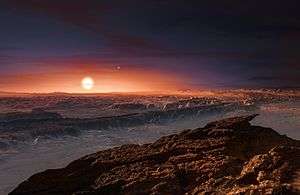Kepler-1638b
| Exoplanet | List of exoplanets | |
|---|---|---|
| Parent star | ||
| Star | Kepler-1638 | |
| Constellation | Cygnus | |
| Right ascension | (α) | 19h 41m 55.78s |
| Declination | (δ) | +48° 31′ 28.0″ |
| Distance | 2867+488.5 −250.4 ly (879+149.8 −76.8 pc) | |
| Mass | (m) | 0.970+0.049 −0.059 M☉ |
| Radius | (r) | 0.950+0.166 −0.079 R☉ |
| Temperature | (T) | 5710.0+96.7 −111.4 K |
| Metallicity | [Fe/H] | −0.010+0.141 −0.188 |
| Age | 4.37+4.19 −2.59 Gyr | |
| Orbital elements | ||
| Orbital period | (P) | 259.337±0.013 d |
| Physical characteristics | ||
| Radius | (r) | 1.87+0.33 −0.22 R⊕ |
| Discovery information | ||
| Discovery date | 2016 | |
| Discoverer(s) | Ames Research Center | |
| Discovery method | Transit | |
| Discovery status | Published | |
| Other designations | ||
| KOI-5856.01, KOI-5856 b, KIC 11037818 b, 2MASS J19415577+4831280 b, WISE J194155.75+483128.2 b | ||
| Database references | ||
| Extrasolar Planets Encyclopaedia | data | |
| SIMBAD | data | |
| Exoplanet Archive | data | |
| Open Exoplanet Catalogue | data | |
Kepler-1638 b is an exoplanet in orbit of its star, Kepler-1638, located in the constellation Cygnus. The planet is a super-Earth, with a radius of 1.87+0.33
−0.22 R⊕, and an orbit of 259.337±0.013 days in its system's habitable zone.[1][2][3]
See also
References
- ↑ "Kepler-1638 b". NASA Exoplanet Science Institute. 10 May 2016. Retrieved 2016-05-11.
- ↑ Morton, Timothy D.; Bryson, Stephen T.; Coughlin, Jeffrey L.; Rowe, Jason F.; Ravichandran, Ganesh; et al. (May 2016). "False Positive Probabilities for all Kepler Objects of Interest: 1284 Newly Validated Planets and 428 Likely False Positives". The Astrophysical Journal. 822 (2). arXiv:1605.02825
 . Bibcode:2016ApJ...822...86M. doi:10.3847/0004-637X/822/2/86.
. Bibcode:2016ApJ...822...86M. doi:10.3847/0004-637X/822/2/86. - ↑ Burgess, Matt (11 May 2016). "Nasa's Kepler telescope just found 1,284 exoplanets". Wired. Retrieved 21 June 2016.
This article is issued from Wikipedia - version of the 6/21/2016. The text is available under the Creative Commons Attribution/Share Alike but additional terms may apply for the media files.

.jpg)
